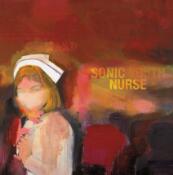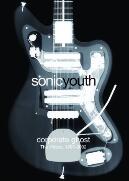Sonic Youth 4 Ever: Sonic Nurse and Corporate Ghost
by dave heaton
 Sonic Youth's career to date has been a shining example of re-investing rock conventions with non-conformist artistic energy and unconventional methods; they're always exploring the intersections between "art" and popular music, while forging their own stylistic path. The Sonic Youth style was captured in an especially explosive way on their 2002 album Murray Street. On it they compacted their free-rock explorations for immediate impact. Their latest album Sonic Nurse doesn't immediately hit as hard. On the first few listens especially, there's a sense of distance to the songs which is quite reminiscent of their 1998 album A Thousand Leaves. The songs are generally slower and dreamier, and the album drifts where their last one punched. But the more I listen to Sonic Nurse the more that impression falls away, the more the album reveals itself to have both a direct impact and more subtle layers. Ultimately Sonic Nurse is an epic work that feels inclusive of everything Sonic Youth has explored over their 20+ year career.
Sonic Youth's career to date has been a shining example of re-investing rock conventions with non-conformist artistic energy and unconventional methods; they're always exploring the intersections between "art" and popular music, while forging their own stylistic path. The Sonic Youth style was captured in an especially explosive way on their 2002 album Murray Street. On it they compacted their free-rock explorations for immediate impact. Their latest album Sonic Nurse doesn't immediately hit as hard. On the first few listens especially, there's a sense of distance to the songs which is quite reminiscent of their 1998 album A Thousand Leaves. The songs are generally slower and dreamier, and the album drifts where their last one punched. But the more I listen to Sonic Nurse the more that impression falls away, the more the album reveals itself to have both a direct impact and more subtle layers. Ultimately Sonic Nurse is an epic work that feels inclusive of everything Sonic Youth has explored over their 20+ year career.
On a surface level, Sonic Nurse includes songs that cover many of the lyrical themes that Sonic Youth have considered in the past. The opener "Pattern Recognition" shares its name with a novel by William Gibson, while "Kim Gordon and the Arthur Doyle Hand Cream" (originally titled "Mariah Carey and the Arthur Doyle Hand Cream") discusses a pop superstar's breakdown (celebrity personas have always fascinated the band, think of Madonna, the Carpenters, etc.). Musically Sonic Nurse finds the group focusing on conventional rock song structure, as they have on most of their recent albums, while leaving room for experimentation within those frameworks. In other words, no song is a straight-out noise attack, yet every song feels fresh and open, with ambiguous notes and broad brushstrokes of sound.
As with their 1994 album Experimental Jet Set, Trash and No Star, many of the songs here started as solo demos by Thurston Moore. More so than on that earlier album, here they've been successfully transitioned into full-band songs, with real scope and fullness. What's left of the solo origin is an emotional directness more typical of a one-person effort than a complicated, swirling Sonic Youth soundscape. "Unmade Bed," a typically Thurston-eque plea to a woman to leave her lunkhead man, the nearly 8-minute "Dripping Dream" (with also typically Thurston Beat-poet lyrics), and the 7-minute "Stones" especially show an intimacy that's a far cry from the portrait of the artists as ice-cold experimentalists that some detractors have painted of them. These are very human songs about people, feelings, and circumstances, even though the lyrics are often abstract and surrealistic. There's a real force to their songs, whether they're speaking out against an unethical war ("Peace Attack") or singing about something too enigmatic to completely pin down. The real emotional impact of Sonic Nurse comes through the lyrics and the way they're delivered (notice how "I Love You Golden Blue" gains a ton of power through Kim Gordon's delicate yet edgy singing), but it's also through the music itself - listen to the beautiful, spooky high notes played on guitar at the start of "New Hampshire," or the ghostly set-up to "Paper Cup Exit" - and, most importantly, the way it all wraps together.
 Nowadays Sonic Youth seems to be generally held in a higher esteem than they were, say, 5 years ago. But for my money they've yet to release a truly flawed album. I can think of no other rock band in existence that's been making as consistently interesting and spellbinding music for as long. Concurrently with Sonic Nurse, the band released a DVD collection that offers another opportunity for indulging in the band's greatness. Corporate Ghost, subtitled "The Videos: 1990-2002," collects the visual side of the band since 1990, when they signed to Geffen Records and proved you can become a major-label rock band without compromising your music or integrity. Sonic Youth has always been a band closely tied to other parts of the art world; besides being involved in various literary and visual art projects of their own, they've used visual art by an assortment of unique contemporary artists as album covers (their latest uses paintings by Richard Prince). And they've generally approached the music video world from that same perspective, preferring visually striking imagery and techniques over gloss and poses. For their first major-label album, Goo, they had a director they liked tackle each one of the album's songs, an unconventional project to say the least. Those 11 videos shift the balance of the videos on Corporate Ghosts, time-wise, towards that moment immediately before the Nirvana explosion, before "alternative rock" became a corporate buzzword, when some previously "underground" bands like Sonic Youth were starting to get attention in an organic, non-hype-based way. The Goo videos are all over the map in terms of look and feel, from Tamra Davis' relatively polished (but still quite cool) videos for the singles "Dirty Boots" and "Kool Thing" to the very homemade video for "My Friend Goo."
Nowadays Sonic Youth seems to be generally held in a higher esteem than they were, say, 5 years ago. But for my money they've yet to release a truly flawed album. I can think of no other rock band in existence that's been making as consistently interesting and spellbinding music for as long. Concurrently with Sonic Nurse, the band released a DVD collection that offers another opportunity for indulging in the band's greatness. Corporate Ghost, subtitled "The Videos: 1990-2002," collects the visual side of the band since 1990, when they signed to Geffen Records and proved you can become a major-label rock band without compromising your music or integrity. Sonic Youth has always been a band closely tied to other parts of the art world; besides being involved in various literary and visual art projects of their own, they've used visual art by an assortment of unique contemporary artists as album covers (their latest uses paintings by Richard Prince). And they've generally approached the music video world from that same perspective, preferring visually striking imagery and techniques over gloss and poses. For their first major-label album, Goo, they had a director they liked tackle each one of the album's songs, an unconventional project to say the least. Those 11 videos shift the balance of the videos on Corporate Ghosts, time-wise, towards that moment immediately before the Nirvana explosion, before "alternative rock" became a corporate buzzword, when some previously "underground" bands like Sonic Youth were starting to get attention in an organic, non-hype-based way. The Goo videos are all over the map in terms of look and feel, from Tamra Davis' relatively polished (but still quite cool) videos for the singles "Dirty Boots" and "Kool Thing" to the very homemade video for "My Friend Goo."
The rest of the collection quickly runs through the rest of Sonic Youth's career to date. There's a few videos from Dirty, and then 1 or 2 from each album after that, plus their rather odd version of "Superstar" for the Carpenters tribute album. Everything is of course well-documented with friendly commentary tracks, and there's a series of short films with friends and collaborators (Mike Watt, Kathleen Hanna, Spike Jonze), to help make the DVD a portrait of Sonic Youth as much as just a video collection. But the videos alone make Corporate Ghost worthwhile. Sonic Youth isn't a band that needs videos to make their music interesting, but the videos do nicely complement the SY aesthetic. In one of the interviews on the DVD, someone says that Sonic Youth approach their videos like little short films. Given the groups' artistic tastes and interests, it follows logically that their videos would be different from your average MTV videos, and generally speaking they are. And most stand as interesting pieces of filmmaking, period, like Harmony Korine's video for "Sunday," starring an out-of-the-spotlight Macauley Cuulkin, or Todd Haynes' glitzy yet gritty noir video for "Disappearer," or Lee Renaldo's own video for "Hoarfrost," one of the clips here that definitely didn't receive much airplay on MTV (even late at night). When people are paying attention and when they're not, Sonic Youth is excelling at their own unique style of art. Personally, I can't get enough of them. Bring on more DVD collections, more albums, more weirdo EPs or whatever, for as long as time allows. Between Sonic Nurse, Corporate Ghost, the used cassette copy of Sonic Death that I picked up the other day, and the streaming "mix tape" of rare Sonic Youth songs that they've got up on their web site (not to mention their extensive, brilliant back catalogue), I'm all set for the summer.
Copyright (c) 2005 erasing clouds |
|